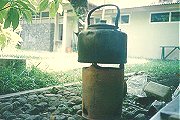

Indonesia 
 |
Wood Energy Situation Policies and Programmes Wood Energy Data Further Reading RWEDP Focal Points |
Wood Energy Situation
Indonesia is rich in both conventional and biomass energy sources. Woodfuels account for 29% of total energy consumption. Almost all rural households use woodfuels, mainly for cooking, and also a substantial amount of urban households are woodfuel users, indicating a sizeable flow of traded woodfuels from rural areas to cities. In addition, village industries such as charcoal, brick, ceramics and tile making, and lime burning use fuelwood.
Indonesia is still known for its large forest areas - 60% of the total land area. Large scale logging of natural forests takes place for the pulp and paper industry and for timber. The Government is committed to implementing sustainable forest management by the year 2000. On the populated island of Java, about two-thirds of woodfuels does not come from the forests, and on West-Java as much as 93% of all fuelwood comes from village lands, mainly from mixed home-gardens.
Policies and Programmes
The Forest Products and Socio-economics Research and Development Centre (in Bogor), under the Ministry of Forestry, has been engaged in studies on woodfuel utilisation. It is reported that the demand for fuelwood is higher than the amount produced, and is projected to increase by another 5% in the period 1995-2000, particularly in industry. There is probably still substantial scope for putting waste from the logging and wood industries to good use as fuel, for instance in Kalimantan. This would at the same time alleviate environmental burdens resulting from the waste. The Ministry of Forestry is also interested in gasification and briquetting technologies. The centre has completed a study on gender and wood energy. 
The Ministry of Mines and Energy, in particular the Directorate General for Electricity and Energy Development, continues to take a strong interest in wood and biomass energy. This Directorate is also involved in improved cookstove programmes, started as a result of an International Workshop on this subject which was jointly organised by RWEDP, ITDG, GTZ and ARECOP, in Sri Lanka in 1992.
ARECOP, as a regional NGO based in Indonesia, plays an important role in stimulating the development and dissemination of improved cookstoves and related issues in the region.
Wood Energy Data
| General | |||||
| Population (1996) | 200.5 mln. | ||||
| Share of Rural Population | 63.6% | ||||
| GDP per capita (1995) in constant 1987 US$ | 655 | ||||
| Energy Consumption (1995) | |||||
| Total Final Energy Consumption in PJ | 3,107 | ||||
| Consumption of Wood Energy in PJ | 939 | (30.2%) | |||
| Consumption of Biomass Energy in PJ | 1,173 | (37.8%) | |||
| Wood Energy Resources | |||||
| Forest Area (1995) in 1000 ha | 109,791 | (60.6%) | |||
| Natural Forest Area (1995) in 1000 ha | 103,666 | (57.2%) | |||
| Agricultural Area (1994) in 1000 ha | 41,971 | (23.2%) | |||
| Share of Woodfuels from Forest Areas | NA | ||||
| Potential Wood Energy Supply (1994) | |||||
| Sust. Supply from Natural Forest in kton | 161,711 | ||||
| Sust. Supply from Forest Plantations in kton | 21,394 | ||||
| Sust. Supply from Agriculture Areas in kton | 67,744 | ||||
| Sust. Supply from Other Wooded Land in kton | 6,673 | ||||
| Supply from Wood Waste from Deforestation in kton | 181,526 | ||||
| Total Potential Supply in kton | 439,049 | ||||
| Primary Wood Energy Requirements in kton | 459,470 | ||||
Notes:
Population and land use data from FAO (FAOSTAT), GDP per capita from World Bank. Energy consumption data from various sources.
Potential wood energy supply estimated by RWEDP, based on available data for land use, wood productivity and estimates on availability of wood for energy use. For forest land, other wooded land and agriculture areas, the potential supply is based on average annual yield estimates, assuming a sustainable use of resources (Sust.: sustainable). Wood waste from deforestation refers to wood potentially available from natural forest land cleared due to commercial logging, expansion of agriculture land or other reasons. The estimates are based on aggregated national data, which can hide local variations, ranging from scarcity to abundance. For detailed calculations and estimates for 2010, see FD50, chapter 8
Further reading:
| Regional Study on Wood Energy Today and Tomorrow in Asia, Field Document 50, 1997 | |
| Chapter 7 in Review of Wood Energy Data in RWEDP Member Countries, Field Document 47, 1997 | |
| Biomass Energy in Asean Member Countries, 1997 | |
| Part IV "Rural-Urban Interdependencies in the Commercial Wood Energy System in Majalaya Sub-district, West-Java" in Woodfuel Flows, Rapid Rural Appraisal in Four Asian Countries, Field Document 26, 1991 | |
| Social Forestry in Indonesia, Field Document 25, 1990 |
RWEDP Focal Points in Indonesia
Focal points are the main contacts for RWEDP in a member country. Generally, in each country, there is one focal point in the energy sector, and one in the forestry sector.
| Director for Energy Development Directorate General of Electricity and Energy Department Ministry of Energy Jalan HR Rasuan Said X2/07-08 Kuningan, Jakarta 12950 TEL: 62-21-5225180 FAX: 62-21-5256044 | Director of Afforestation and Social Forestry Directorate General of Reforestation and Rehabilitation Ministry of Forestry Manggala Wanabakti Building Jl. Gatot Subroto, Jakarta TEL: 62-21-5730152/150 FAX: 62-21-5737092 |
Comments, questions? webmaster@rwedp.org
© FAO-RWEDP, 1999